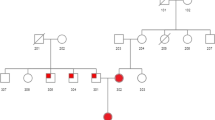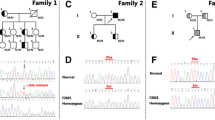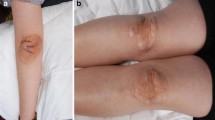Abstract
Familial Hypercholesterolemia (FH) results in elevated levels of blood lipids including total cholesterol (TC) and low density lipoprotein cholesterol (LDL-C) with normal triglycerides (TG). This disease is one of the major contributors towards an early onset of coronary heart disease (CHD). The aim of the present study was to identify the genes responsible for causing FH in Pakistani population, for this purpose a large consanguineous FH family was selected for genetic analysis. Serum lipid levels, including TC, TG, LDL-C and high density lipoprotein cholesterol (HDL-C), were determined in patients and healthy controls. In order to find the causative mutation in this family, direct sequencing of the low density lipoprotein receptor (LDLR) gene was performed. In addition the part of the Apolipoprotein-B (APOB) gene containing the mutations R3500Q and R3500W was also sequenced. Affected individuals of the family were found to have raised TC and LDL-C levels. Sequencing revealed an insertion mutation (c.2416_2417InsG) in exon 17 of the LDLR gene in all the affected individuals of the family. Common FH causing APOB mutations were not present in this family. Heterozygous individuals had TC levels ranging from ~300–500 mg/dl and the only homozygous individual with typical xanthomas had TC levels exceeding 900 mg/dl. This is the first report of a known LDLR gene mutation causing FH in the Pakistani population. Despite a large heterogeneity of LDLR mutations there are still some common mutations which are responsible for FH throughout the world.



Similar content being viewed by others
References
Brown MS, Goldstein JL (1986) A receptor-mediated pathway for cholesterol homeostasis. Science 232:34–47
Bourbon M, Alves AC, Medeiros AM, Silva S, Soutar AK, Investigators of Portuguese FH Study (2008) Familial hypercholesterolemia in Portugal. Atherosclerosis 196:633–642
Austin MA, Hutter CM, Zimmern RL, Humphries SE (2004) Genetic causes of monogenic heterozygous familial hypercholesterolemia: a HuGE prevalence review. Am J Epidemiol 160:407–420
Cheng X, Ding J, Zheng F, Zhou X, Xiong C (2009) Two mutations in LDLR gene were found in two Chinese families with familial hypercholesterolemia. Mol Biol Rep 36:2053–2057
Varret M, Abifadel M, Rabès JP, Boileau C (2008) Genetic heterogeneity of autosomal dominant hypercholesterolemia. Clin Genet 73:1–13
Sozen M, Whittall R, Humphries SE (2004) Mutation detection in patients with familial hypercholesterolemia using heteroduplex and single strand conformation polymorphism analysis by capillary electrophoresis. Atheroscler Suppl 5:7–11
Jelassi A, Najah M, Jguirim I, Maatouk F, Lestavel S, Laroussi OS, Rouis M, Boileau C, Rabès JP, Varret M, Slimane MN (2008) A novel splice site mutation of the LDL receptor gene in a Tunisian hypercholesterolemic family. Clin Chim Acta 392:25–29
Pandit S, Wisniewski D, Santoro JC, Ha S, Ramakrishnan V, Cubbon RM, Cummings RT, Wright SD, Sparrow CP, Sitlani A, Fisher TS (2008) Functional analysis of sites within PCSK9 responsible for hypercholesterolemia. J Lipid Res 49:1333–1343
Leigh SE, Foster AH, Whittall RA, Hubbart CS, Humphries SE (2008) Update and analysis of the University College London low density lipoprotein receptor familial hypercholesterolemia database. Ann Hum Genet 72:485–498
Marks D, Thorogood M, Neil HA, Humphries SE (2003) A review on the diagnosis, natural history, and treatment of familial hypercholesterolemia. Atherosclerosis 168:1–14
Williams RR, Hunt SC, Schumacher MC, Hegele RA, Leppert MF, Ludwig EH, Hopkins PN (1993) Diagnosing heterozygous familial hypercholesterolemia using new practical criteria validated by molecular genetics. Am J Cardiol 72:171–176
Sambrook J, Fritsch EF, Maniatis T (1989) Molecular cloning: a laboratory manual, 2nd edn. Cold Spring Harbor, New York
Yang KC, Su YN, Shew JY, Yang KY, Tseng WK, Wu CC, Lee YT (2007) LDLR and ApoB are major genetic causes of autosomal dominant hypercholesterolemia in a Taiwanese population. J Formos Med Assoc 106:799–807
Hobbs HH, Russell DW, Brown MS, Goldstein JL (1990) The LDL receptor locus in familial hypercholesterolemia: mutational analysis of a membrane protein. Annu Rev Genet 24:133–170
Goldstein JL, Brown MS (1977) The low-density lipoprotein pathway and its relation to atherosclerosis. Annu Rev Biochem 46:897–930
Goldstein JL, Brown MS, Anderson RG, Russell DW, Schneider WJ (1985) Receptor-mediated endocytosis: concepts emerging from the LDL receptor system. Annu Rev Cell Biol 1:1–39
Ekstrom U, Abrahamson M, Wallmark A, Floren CH, Nilsson-Ehle P (1998) Mutations in the low-density lipoprotein receptor gene in Swedish familial hypercholesterolaemia patients: clinical expression and treatment response. Eur J Clin Invest 28:740–747
Nobe Y, Emi M, Katsumata H, Nakajima T, Hirayama T, Wu LL, Stephenson SH, Hopkins PN, Williams RR (1999) Familial hypercholesterolemia in Utah kindred with novel 2412-6 Ins G mutations in exon 17 of the LDL receptor gene. Jpn Heart J 40:435–441
Kuhrova V, Francova H, Zapletalova P, Freiberger T, Fajkusova L, Hrabincova E, Slovackova R, Kozak L, Slovakova R (2002) Spectrum of low density lipoprotein receptor mutations in Czech hypercholesterolemic patients. Hum Mutat 19:80
Fouchier SW, Defesche JC, Umans-Eckenhausen MW, Kastelein JP (2001) The molecular basis of familial hypercholesterolemia in The Netherlands. Hum Genet 109:602–615
Yu W, Nohara A, Higashikata T, Lu H, Inazu A, Mabuchi H (2002) Molecular genetic analysis of familial hypercholesterolemia: spectrum and regional difference of LDL receptor gene mutations in Japanese population. Atherosclerosis 165:335–342
Burden JJ, Sun XM, García AB, Soutar AK (2004) Sorting motifs in the intracellular domain of the low density lipoprotein receptor interact with a novel domain of sorting Nexin-17. J Biol Chem 279:16237–16245
Zhang DW, Garuti R, Tang WJ, Cohen JC, Hobbs HH (2008) Structural requirements for PCSK9-mediated degradation of the low-density lipoprotein receptor. Proc Natl Acad Sci USA 105:13045–13050
Chen WJ, Goldstein JL, Brown MS (1990) NPXY, a sequence often found in cytoplasmic tails, is required for coated pit-mediated internalization of the low density lipoprotein receptor. J Biol Chem 265:3116–3123
Garuti R, Jones C, Li WP, Michaely P, Herz J, Gerard RD, Cohen JC, Hobbs HH (2005) The modular adaptor protein autosomal recessive hypercholesterolemia (ARH) promotes low density lipoprotein receptor clustering into clathrin-coated pits. J Biol Chem 280:40996–41004
Wu JH, Peppel K, Nelson CD, Lin FT, Kohout TA, Miller WE, Exum ST, Freedman NJ (2003) The adaptor protein beta-arrestin2 enhances endocytosis of the low density lipoprotein receptor. J Biol Chem 278:44238–44245
Davis CG, van Driel IR, Russell DW, Brown MS, Goldstein JL (1987) The low density lipoprotein receptor. Identification of amino acids in cytoplasmic domain required for rapid endocytosis. J Biol Chem 262:4075–4082
Kibbey RG, Rizo J, Gierasch LM, Anderson RGW (1998) The LDL receptor clustering motif interacts with the clathrin terminal domain in a reverse turn conformation. J Cell Biol 142:59–67
Maurer ME, Cooper JA (2006) The adaptor protein Dab2 sorts LDL receptors into coated pits independently of AP-2 and ARH. J Cell Sci 119:4235–4246
Stanley JC (2008) Feedback inhibition of cholesterol synthesis and uptake. Lipid Technol 20:17–18
Li JJ (2009) Triumph of the heart: the story of statins, 1st edn. Oxford, New York, USA
Snozek CL, Lagerstedt SA, Khoo TK, Rubenfire M, Isley WL, Train LJ, Baudhuin LM (2009) LDLR promoter variant and exon 14 mutation on the same chromosome are associated with an unusually severe FH phenotype and treatment resistance. Eur J Hum Genet 17:85–90
Goharkhay N, Tamayo EH, Yin H, Hankins GD, Saade GR, Longo M (2008) Maternal hypercholesterolemia leads to activation of endogenous cholesterol synthesis in the offspring. Am J Obstet Gynecol 199:273.e1–273.e6
Moyle M, Tate B (2004) Homozygous familial hypercholesterolaemia presenting with cutaneous xanthomas: Response to liver transplantation. Australas J Dermatol 45:226–228
Bukhari SA, Rajoka MI, Nagra SA, Rehman ZU (2010) Plasma homocysteine and DNA damage profiles in normal and obese subjects in the Pakistani population. Mol Biol Rep 37:289–295
Ying S, Liu XM, Sun YM, Pan SH (2010) Genetic polymorphism c.1438A>G of the 5-HT(2A) receptor is associated with abdominal obesity in Chinese Northern Han population. Mol Biol Rep 36:91–95
Chen Z, Ding Z, Ma G, Liu N, Qian Q (2010) Sterol regulatory element-binding transcription factor (SREBF)-2, SREBF cleavage-activating protein (SCAP), and premature coronary artery disease in a Chinese population. Mol Biol Rep [Epub ahead of print]
Hu P, Qin YH, Jing CX, Lei FY, Chen P, Li MF (2009) Association of polymorphisms at restriction enzyme recognition sites of apolipoprotein B and E gene with dyslipidemia in children undergoing primary nephrotic syndrome. Mol Biol Rep 36:1015–1021
Ikonen E (2006) Mechanisms for cellular cholesterol transport: defects and human disease. Physiol Rev 86:1237–1261
Acknowledgements
We are thankful to the family members who participated in this study. This work was financially supported by grant no. 934 from the Higher Education Commission of Pakistan, awarded to RQ. Part of this work was supported by Shifa College of Medicine through a core grant to RQ. We are grateful to Tommy Hyatt, Lab Manager for Dr. Helen H. Hobbs’s Laboratory, McDermott Center for Human Growth and Development, USA, for providing the LDLR primer sequences.
Author information
Authors and Affiliations
Corresponding author
Electronic supplementary material
Below is the link to the electronic supplementary material.
Rights and permissions
About this article
Cite this article
Ajmal, M., Ahmed, W., Sadeque, A. et al. Identification of a recurrent insertion mutation in the LDLR gene in a Pakistani family with autosomal dominant hypercholesterolemia. Mol Biol Rep 37, 3869–3875 (2010). https://doi.org/10.1007/s11033-010-0043-0
Received:
Accepted:
Published:
Issue Date:
DOI: https://doi.org/10.1007/s11033-010-0043-0




